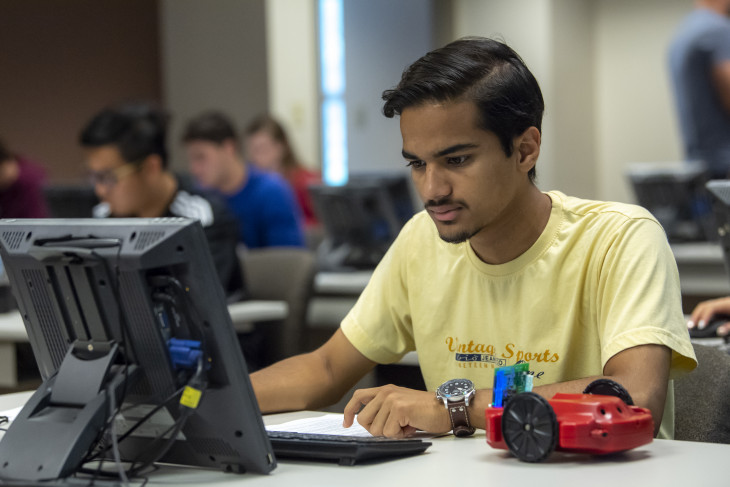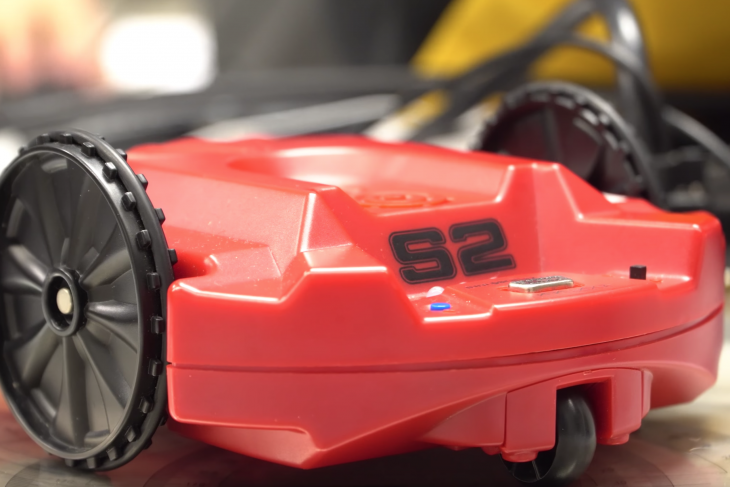You’ve signed up to take Computer Science 1 and you’re a little trepidatious. You’re game to learn the basics of computer programming but, on the first day of class, it’s all Greek to you.
And then your professor, Doug Harms, tells you and your classmates: “Oh, yeah. We’re going to use robots…
“They seemed pretty happy,” Harms says, recalling his students’ reaction on that first day back in August. “It’s always fun the first time you get it connected in class. It takes a while to actually get the computer talking to the robot. Then you say, ‘OK, now do this,’ and the robot starts moving and you go, ‘Ah!’”
Harms says that he and his colleagues who teach CS1 “want to get students excited about computer science,” and he opts to use robots to do so.
“For a number of students, when they have something working on the screen, it’s fun,” he says. “But having it change the world? I mean, … you write a program and something in the world is moving around, something in the world is happening. I think that’s fun and I think students think it’s fun too.”
He used robots when he taught CS1 several years ago and has had graduates tell him that learning with robots “got me enthusiastic and inspired.”
Now, mind you, these robots aren’t as sophisticated as Sophia, the lifelike robot that visited campus in February; as utilitarian as Rosie from “The Jetsons” or your Roomba; or as recognizable as R2D2 or the Energizer Bunny.
With wheels on either side of a red body and a small wheel in back, the CS1 robots resemble a miniature Slingshot motorcycle. They come equipped with a green printed circuit board containing a camera and a wireless Bluetooth adapter. A pen, point down, can be placed in a hole in the very center of the robot so students can track their machine’s movements with marks on a paper.
It’s a way to introduce the concepts of computer science in a way they’ll find interesting and exciting.– Doug Harms
Corri Rusk ’21 says it was a happy surprise to learn on the first day of class that she’d be working with a robot. “I was really excited,” she says, “because this wasn’t what I expected.”
Rusk took the content-preview class that the Computer Science Department holds to entice first-year women to consider enrolling in CS1. That experience persuaded her to do just that and now, further intrigued by her experience with the robot, she says she is considering a computer science major.
“This could help me decide if I want to major or not,” she says. “I think it’s a real useful class.”

Harms acknowledges that the material taught in some elementary and high school computer science programs might be similar to that covered in his CS1 course. This is, after all, the most basic computer science class and DePauw’s department assumes that students who take it have no previous experience with programming. But at the college level, the concepts are more sophisticated and, as students tackle problem-solving, they’re taught to be particularly aware of how a slight change may crash their entire algorithm.
He also concedes that using robots not only is practical – students can visualize the results of their work – but also is a gimmick. And he has no problem with that.
“It’s a platform in which you can program and it’s fun,” he says. “It’s a way to introduce the concepts of computer science in a way they’ll find interesting and exciting.”
Browse other stories
-
Athletics
-
Women's Golf - Williams Selected Academic All-America®
-
Football - 336 Students Named to 2025 Spring Tiger Pride Honor Roll
-
Football - DePauw-Record 190 Student-Athletes Named to NCAC's Dr. Gordon Collins Scholar-Athlete Honor Roll
More Athletics
-
-
News
-
Outstanding scholars named to Spring 2025 Dean's List
-
Alumni News Roundup - June 6, 2025
-
Transition and Transformation: Inside the First-Year Experience
More News
-
-
People & Profiles
-
11 alums make list of influential Hoosiers
-
DePauw welcomes Dr. Manal Shalaby as Fulbright Scholar-in-Residence
-
DePauw Names New Vice President for Communications and Strategy and Chief of Staff
More People & Profiles
-
-
Have a story idea?
Whether we are writing about the intellectual challenge of our classrooms, a campus life that builds leadership, incredible faculty achievements or the seemingly endless stories of alumni success, we think DePauw has some fun stories to tell.
-
Communications & Marketing
101 E. Seminary St.
Greencastle, IN, 46135-0037
communicate@depauw.eduNews and Media
-
News media: For help with a story, contact:
Bob Weaver, Senior Director of Communications.
bobweaver@depauw.edu.
